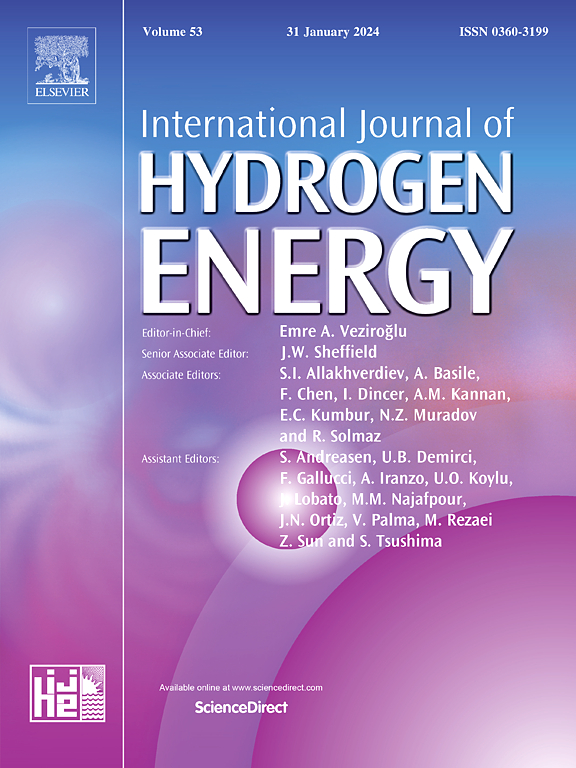The pre-chamber dominated diffusion combustion: Toward heavy-duty hydrogen engines
IF 8.3
2区 工程技术
Q1 CHEMISTRY, PHYSICAL
引用次数: 0
Abstract
Achieving high power density remains a major challenge for heavy-duty hydrogen engines, hindered by issues like knocking and backfire associated with premixed combustion. This study proposed a novel pre-chamber concept termed the combustion-assisted fuel supply chamber (CAFSC) to enable diffusion combustion, thereby mitigating knocking risks and enhancing power density. All hydrogen is supplied by low-pressure direct injection into the CAFSC, while air is introduced through the manifold. Ignition within the CAFSC generates pressure that drives the fuel into the main chamber (MC), inducing diffusion combustion. Experiments conducted on an optical constant volume combustion chamber (CVCC) confirmed the feasibility of the CAFSC-dominated diffusion combustion process and investigated the effects of global equivalence ratio (ΦG), nozzle diameter (d), and nozzle number (n). Key findings demonstrate that the CAFSC approach achieves stable and controllable heat release. Crucially, combustion duration (tdur) and ignition delay (tdelay) are significantly shorter than conventional passive pre-chambers (PPC) and exhibit minimal sensitivity to variations in ΦG. Furthermore, appropriately increasing d and n reduces tdur and tdelay while improving the burnt fuel ratio (BFR). The optimized configuration (n = 3, d = 6 mm) achieved a BFR comparable to PPC (97.9 %) while significantly accelerating combustion. However, an excessively large total connecting area induces unstable flame front development. The CAFSC presents a viable pathway towards high-power-density, knock-free hydrogen engines through controllable diffusion combustion.
预燃烧室主导的扩散燃烧:走向重型氢发动机
实现高功率密度仍然是重型氢发动机面临的主要挑战,预混燃烧带来的爆震和回火等问题阻碍了重型氢发动机的发展。本研究提出了一种新的预燃室概念,称为燃烧辅助燃料供应室(CAFSC),以实现扩散燃烧,从而降低爆震风险并提高功率密度。所有的氢气都通过低压直接注入到CAFSC中,而空气则通过歧管引入。CAFSC内的点火产生压力,驱动燃料进入主燃烧室(MC),诱发扩散燃烧。在光学定容燃烧室(CVCC)上进行的实验证实了cafsc主导的扩散燃烧过程的可行性,并研究了整体等效比(ΦG)、喷嘴直径(d)和喷嘴数量(n)的影响。关键研究结果表明,CAFSC方法可以实现稳定可控的放热。至关重要的是,燃烧持续时间(tdur)和点火延迟(tdelay)明显短于传统的被动预室(PPC),并表现出最小的敏感性变化ΦG。此外,适当增加d和n可降低tdur和delay,提高燃烧燃料比(BFR)。优化后的结构(n = 3, d = 6 mm)在显著加速燃烧的同时,实现了与PPC相当的BFR(97.9%)。然而,过大的总连接面积会导致火焰前缘发展不稳定。通过可控扩散燃烧,CAFSC为实现高功率密度、无碰撞的氢发动机提供了一条可行的途径。
本文章由计算机程序翻译,如有差异,请以英文原文为准。
求助全文
约1分钟内获得全文
求助全文
来源期刊

International Journal of Hydrogen Energy
工程技术-环境科学
CiteScore
13.50
自引率
25.00%
发文量
3502
审稿时长
60 days
期刊介绍:
The objective of the International Journal of Hydrogen Energy is to facilitate the exchange of new ideas, technological advancements, and research findings in the field of Hydrogen Energy among scientists and engineers worldwide. This journal showcases original research, both analytical and experimental, covering various aspects of Hydrogen Energy. These include production, storage, transmission, utilization, enabling technologies, environmental impact, economic considerations, and global perspectives on hydrogen and its carriers such as NH3, CH4, alcohols, etc.
The utilization aspect encompasses various methods such as thermochemical (combustion), photochemical, electrochemical (fuel cells), and nuclear conversion of hydrogen, hydrogen isotopes, and hydrogen carriers into thermal, mechanical, and electrical energies. The applications of these energies can be found in transportation (including aerospace), industrial, commercial, and residential sectors.
 求助内容:
求助内容: 应助结果提醒方式:
应助结果提醒方式:


